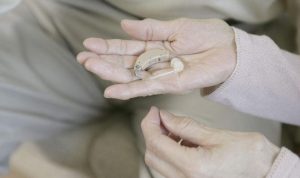Compared with adults, children’s auditory organs are different in anatomy and physiology. Pay attention to the following problems when wearing hearing aids:
(1) The auricle is small and soft, and the supporting force is poor. Therefore, the volume of the hearing aid should be reduced as much as possible under the premise of ensuring the acoustic gain.
(2) Inner ear hair cells are less able to withstand strong acoustic stimulation, so the maximum acoustic output of hearing aids is strictly limited. It is best to use hearing aids with compression amplification lines.
(3) The hearing sensitivity of children in this age group is low, and the criteria for older children and adults cannot be used when evaluating the effects of hearing aids.
(4) Children like to pull the hearing aid off, and spring clips, hats and headbands help ensure that the child does not pull the hearing aid off. Audiologists can help choose the right item for your child.
(5) Sometimes it’s hard to put the ear mold into the ear of a child. Special lubricants and good techniques may help.
(6) The sound hole of the ear mold is small and easy to block, so it should be cleaned frequently.
(7) The period for evaluating hearing aid effects is short, at least once a month.
(8) Children’s body parts develop rapidly, ear molds are replaced more frequently, and need to be changed every 1-3 months.
Hearing aids, as the name implies, help to restore their hearing. After wearing a hearing aid, don’t expect to hear the voice and understand all the words right away. This requires an adaptation process. Things to be aware of when children wear hearing aids:
(1) cultivating children’s interest in wearing hearing aids: When you first wear them, wearing the same eyes and dentures, you will feel uncomfortable at first. Some children will cry when they wear a hearing aid, or they will use their hands to catch them. Parents should find a way. Transfer the child’s attention or give the child a demonstration exercise, so that they feel very happy and comfortable after wearing the hearing aid, and cultivate a good habit of wearing a hearing aid.
(2) Use in a quiet environment: When you are wearing a hearing aid, don’t go to the downtown area or the road. This will make the child feel noisy and uncomfortable in the ear. You should use it in a familiar and quiet environment and practice listening. Familiar sounds, such as running water, closing sounds, telephone ring tones, etc., are gradually worn in a diverse sound environment to foster the ability of children to adapt to various sounds. (3) The initial wear time should not be too long: children wear hearing aids at first, often feel uncomfortable. This requires an adaptation process. Generally, in about two weeks, the volume should not be too big when starting to wear, and then gradually increase, gradually Extend the wearing time. If the child feels tired or uncomfortable, take it off immediately, so that after a period of adaptation and exercise, the child will get used to wearing a hearing aid.
(4) Listening language training for children wearing hearing aids: Most hearing-impaired children have some difficulties in understanding others’ speech and expressing their wishes. The pronunciation is not clear, so listening language training is very important. First, let the children understand the language and train the child’s discrimination on various sounds, such as listening to the door, ringing, TV, dog barking, etc., and letting them feel the vibration of the sound while listening to the object by hand. Then develop language skills, start with words, then phrases, simple sentences, and gradually train. In the process, you should also develop your child’s habit of talking and speaking, and let the children grow up in a normal environment. Help children understand and learn more languages.
(5) Hearing aids should be taken care of: Hearing aids are a miniaturized integrated circuit that can affect their operation and service life if not properly maintained. The child is very active and easy to sweat. The sweat will be immersed in the movement. When used, the rubber sleeve and the sleeve can be put on the hearing aid to prevent the sweat from intruding and the hearing aid to get wet. After the hearing aid is damp, do not use a microwave to dry it. When the child sleeps, the hearing aid or ear mold should be removed. Because the material is hard, it is easy to hurt the ear canal and crush. If there is earwax outside the hearing aid, clean it with a dry cloth or a small brush. Do not use detergent.
In addition, pediatric hearing aids and batteries should be placed properly. When the child’s hearing aid or battery is not in use, it should be placed in a place that children and pets cannot reach. It is very dangerous if children are mistakenly chewed as toys, snacks, or swallowed and chewed by pets.
Know more, you can do more for your children, so that they can listen better!
Link:What should you pay attention to when wearing a hearing aid for children?
REF: Hearing Aids Supplier , Bluetooth Hearing Aids, BTE Hearing AidsThe article comes from the Internet. If there is any infringement, please contact [email protected] to delete it.



